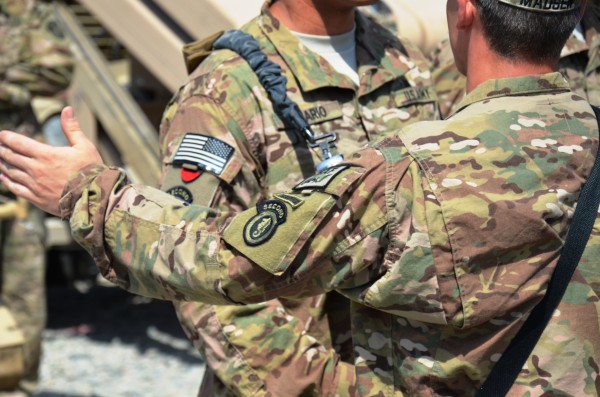
The United States Army is in the midst of a nationwide draw-down that could remove more than 11,000 troops from bases in Alaska during the months ahead. But some units have already started to dissolve as a result of downsizing and sequestration. The deactivation of an engineering unit at Joint Base Elmendorf-Richardson earlier in the month is a small piece amid larger changes for the Army in Alaska.
In a two-story lodge overlooking scenic Otter Lake at Fort Richardson is Captain A. Edward Major (“Soon to be Major Major,” jokes another captain), who shows me a plaque with a castle on it, the emblem for the Engineer Corp.
“We are engineers–we build things,” Major explains. Things like fortifications for combat, represented symbolically by the castle, “They are proud, and they are imposing structures.”
It’s a sad day for Major. His company, the 23rd Engineer Company (engineers who jump out of planes when they have to), deactivated. It is part of the US Army’s strategic shrinking of the overall force. We visit places on base showing the unit’s legacy. One of them is the lodge we’re in, which the 23rd built back in 1974.
“Unfortunately in burned down in 1982,” Major said, “and my company again came back and rebuilt it.”
Engineers fill a peculiar role in the Army, handling what can seem like wildly incompatible responsibilities. Decades ago the unit designed an Alaska-shaped playground on base. But they also returned from a combat deployment in Afghanistan just six months ago, where they would look for roadside bombs, as Major explained, “To make sure some of our less well-protected brethren were not being blown up by the insurgents.”
Since transitioning back to Alaska, Major has worked on dissolving his unit. He shows me a big, empty industrial building that smells like diesel where he and others tied up loose ends, handled all the paperwork of assigning troops to new units, and got commendations in order.
Of the 133 soldiers under his command, around 50 are being absorbed by 4th Brigade of the 25th Infantry Division, and about half are scattering across the globe. It’s a small loss within the larger deactivation of the full 2nd Engineer Brigade, which has shed more than 700 positions from JBER in the last two years, many of them from the more experienced ranks.
“That’s what the Army restructuring was all about,” Major said, “it was a nation-wide effort to figure out where we could accept some risk, and where we needed to reinforce.” Amid that calculus the Army decided Alaska had enough engineering capacity, and opted to shore up units stationed elsewhere.
But that process of making and unmaking is part of the Army, which is constantly adapting to new circumstances, and it’s fundamental to the identity of combat engineers in particular, who refer to themselves as “sappers.”
“It actually goes back to the French word sapeur, and specifically engineers tunneling under enemy fortifications,” Major said. “They would dig under castle walls and buttress them up with wood, then set fire to the wood. So that would literally sap the strength from the wall, and when the wall fell down you could just run in and take the castle.”
Confused, I ask if the insignia for the engineers isn’t at odds with their nickname, “It just sounds like you build castles, but also destroy castles.”
“It is true,” he replied, “we are meant to do both.”
Major is part of the 23rd leaving Alaska. His next posting is at his alma matter, West Point, managing construction projects for the Corp of Engineers.
Zachariah Hughes reports on city & state politics, arts & culture, drugs, and military affairs in Anchorage and South Central Alaska.
@ZachHughesAK About Zachariah




